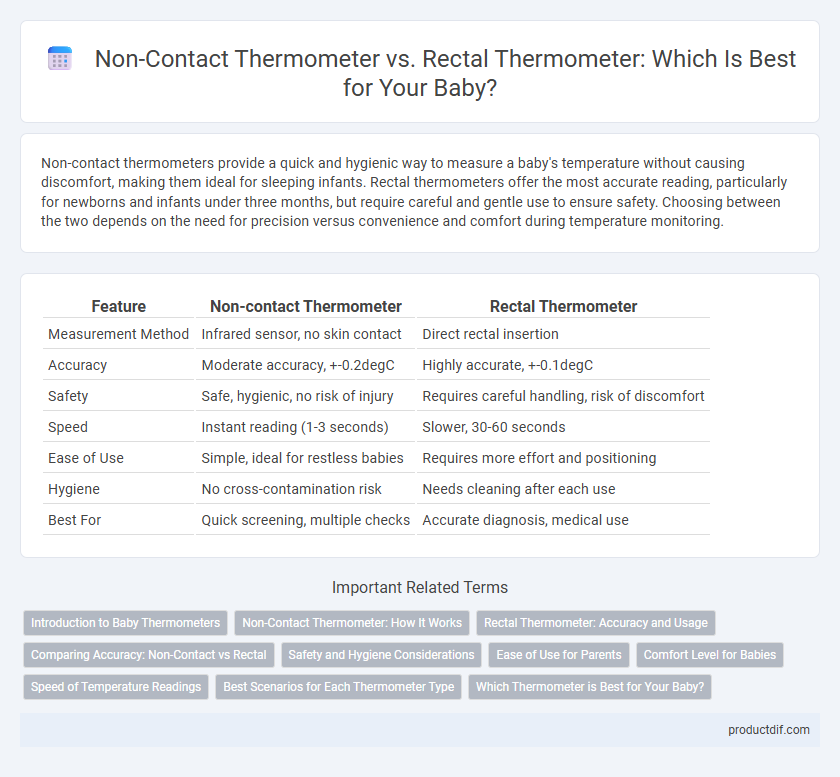Non-contact thermometers provide a quick and hygienic way to measure a baby's temperature without causing discomfort, making them ideal for sleeping infants. Rectal thermometers offer the most accurate reading, particularly for newborns and infants under three months, but require careful and gentle use to ensure safety. Choosing between the two depends on the need for precision versus convenience and comfort during temperature monitoring.
Table of Comparison
| Feature | Non-contact Thermometer | Rectal Thermometer |
|---|---|---|
| Measurement Method | Infrared sensor, no skin contact | Direct rectal insertion |
| Accuracy | Moderate accuracy, +-0.2degC | Highly accurate, +-0.1degC |
| Safety | Safe, hygienic, no risk of injury | Requires careful handling, risk of discomfort |
| Speed | Instant reading (1-3 seconds) | Slower, 30-60 seconds |
| Ease of Use | Simple, ideal for restless babies | Requires more effort and positioning |
| Hygiene | No cross-contamination risk | Needs cleaning after each use |
| Best For | Quick screening, multiple checks | Accurate diagnosis, medical use |
Introduction to Baby Thermometers
Baby thermometers are essential for accurately monitoring infant health, with non-contact and rectal thermometers being the most common types. Non-contact thermometers provide quick, hygienic readings by measuring forehead temperature without physical contact, ideal for fuss-free use. Rectal thermometers offer highly accurate body temperature measurements, making them the trusted choice for newborns and infants requiring precise monitoring.
Non-Contact Thermometer: How It Works
Non-contact thermometers use infrared technology to measure the thermal radiation emitted from a baby's forehead, providing an accurate temperature reading without physical contact. This method minimizes discomfort and reduces the risk of cross-contamination, making it ideal for quick and hygienic temperature checks. Infrared sensors convert the detected heat into an electrical signal, which is then processed and displayed as a digital temperature reading.
Rectal Thermometer: Accuracy and Usage
Rectal thermometers provide the highest accuracy for detecting a baby's core body temperature, essential for diagnosing fevers in infants under three months. Their direct measurement of the rectal temperature minimizes the risk of false readings often encountered with non-contact thermometers. While non-contact thermometers offer convenience, rectal thermometers remain the gold standard in pediatric care for precise temperature monitoring.
Comparing Accuracy: Non-Contact vs Rectal
Rectal thermometers provide the highest accuracy for measuring a baby's core body temperature due to direct internal reading, crucial for detecting fevers in infants. Non-contact thermometers offer quick, hygienic readings by measuring infrared heat from the forehead but can be less precise due to external factors like sweat or room temperature. Choosing between the two depends on the need for exact temperature monitoring versus convenience and non-invasiveness in baby care.
Safety and Hygiene Considerations
Non-contact thermometers offer superior safety by eliminating skin contact, reducing the risk of cross-contamination and infection in babies. Rectal thermometers require thorough sterilization after each use to maintain hygiene, as improper cleaning can lead to bacterial transmission. Prioritizing a non-contact thermometer supports non-invasive temperature measurement and enhances overall hygienic practices in infant care.
Ease of Use for Parents
Non-contact thermometers offer unparalleled ease of use for parents, allowing quick temperature readings without disturbing a sleeping baby or causing discomfort. Rectal thermometers, while highly accurate, often require more time and careful handling, which can be challenging for new parents during stressful moments. Choosing a non-contact thermometer simplifies temperature monitoring with hygienic, touch-free operation and instant results.
Comfort Level for Babies
Non-contact thermometers provide a more comfortable, stress-free experience for babies as they eliminate physical contact and reduce fussiness during temperature checks. Rectal thermometers, while highly accurate, can cause discomfort and distress due to their invasive nature, making them less ideal for frequent use. Comfort level is significantly enhanced with non-contact methods, especially for newborns and infants who are sensitive to touch.
Speed of Temperature Readings
Non-contact thermometers provide temperature readings in just 1 to 3 seconds, making them ideal for quick and gentle checks without disturbing a sleeping baby. Rectal thermometers typically require 1 to 2 minutes to obtain an accurate reading, which can be less convenient but often more precise for core body temperature. Speed of temperature readings is a key factor for parents seeking efficient, stress-free methods to monitor their baby's health.
Best Scenarios for Each Thermometer Type
Non-contact thermometers excel in quick, hygienic fever screenings without disturbing a sleeping baby, making them ideal for routine temperature checks and public health settings. Rectal thermometers provide the most accurate core body temperature readings, essential for infants under three months or when precise fever assessment is critical. Choosing the right thermometer depends on balancing the need for accuracy with convenience and comfort specific to the baby's age and health condition.
Which Thermometer is Best for Your Baby?
Non-contact thermometers offer quick, hygienic, and stress-free temperature readings, ideal for restless or sleeping babies. Rectal thermometers provide the most accurate core body temperature, essential for detecting fever in newborns and infants under three months. Choosing between them depends on the need for precision versus convenience and comfort during temperature measurement.
Non-contact Thermometer vs Rectal Thermometer Infographic

 productdif.com
productdif.com